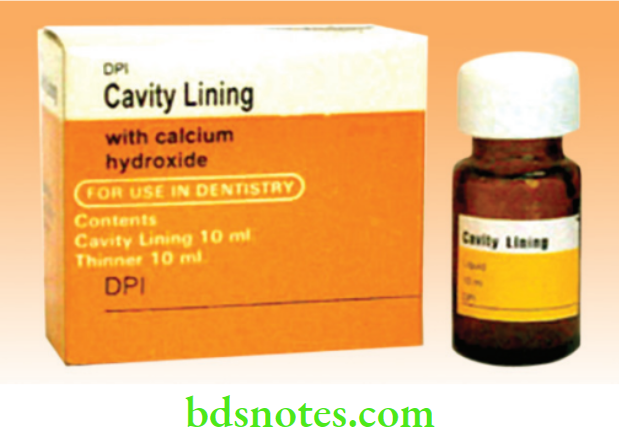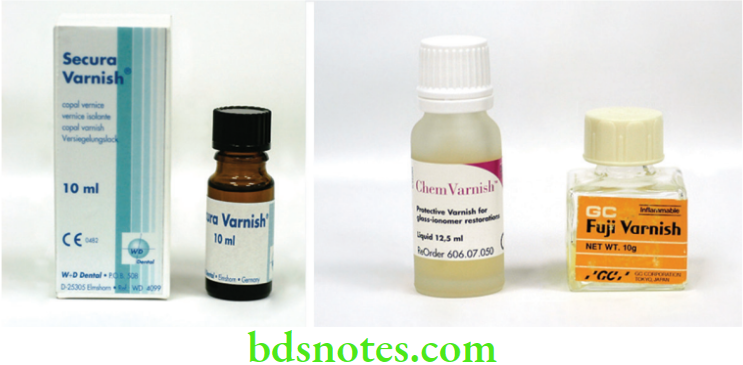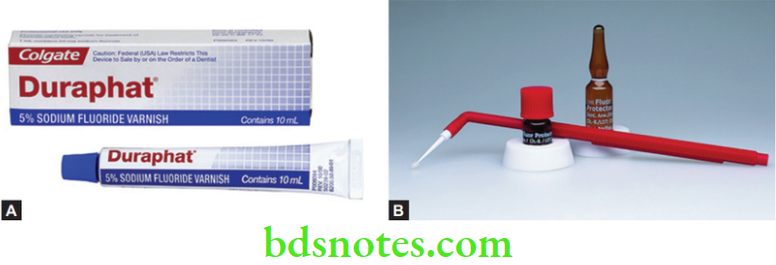Cavity Liners
A cavity liner is used like a cavity varnish to provide a barrier against the passage of irritants from cements or other restorative materials and to reduce the sensitivity of freshly cut dentin. They are usually suspensions of calcium hydroxide in a volatile solvent. Upon the evaporation of the volatile solvent, the liner forms a thin film on the prepared tooth surface.
Supplied As
- Solutions in bottles
- Powder and liquid
- Paste in tubes
Read And Learn More: Basic Dental Materials Notes
Cavity Liners Composition Suspension of calcium hydroxide in an organic liquid such as methyl ethyl ketone or ethyl alcohol. Acrylic polymer beads or barium sulphate calcium monofluorophosphate.

Cavity Liners Properties Like varnishes, cavity liners neither possess mechanical strength nor provide any significant thermal insulation. The calcium hydroxide liners are soluble and should not be applied at the margins of restorations. Fluoride compounds are added to some cavity liners in an attempt to reduce the possibility of secondary caries around permanent restorations or to reduce sensitivity.
Cavity Liners Manipulation Cavity liners are fluid in consistency and can be easily flowed or painted over dentinal surfaces. The solvents evaporate to leave a thin film residue that protects the pulp. The paste form is applied in the cavity and then light cured.
Other Liners Some other materials have been claimed as liners. These include Type III glass ionomer and ZOE.
Cavity Varnish
Cavity varnish is a solution of one or more resins which when applied onto the cavity walls, evaporates leaving a thin resin film, that serves as a barrier between the restoration and the dentinal tubules.
Cavity Varnish Application
- It reduces microleakage around the margins of newly placed amalgam restorations, thereby reducing, postoperative sensitivity.
- It reduces the passage of irritants into the dentinal tubules from the overlying restoration or base, e.g. silicate.
- In amalgam restorations, they also prevent penetration of corrosion products into the dentinal tubules, thus, minimizing tooth discoloration.
- Varnish may be used as a surface coating over certain restorations to protect them from dehydration or contact with oral fluids, e.g. silicate and glass ionomer restorations.
- Varnish may be applied on the surface of metallic restoration as a temporary protection in cases of galvanic shock.
- When electrosurgery is to be done adjacent to metallic restorations, varnish applied over the metallic restorations serves as a temporary electrical insulator.
- Fluoride-containing varnishes release fluoride.
Cavity Varnish Supplied As
- Liquid in regular or dark colored bottles.
- Commercial Names Harvard lac, Chem Varnish, Secura, Fuji Varnish (GC)
Cavity Varnish Composition Natural gum such as copal, resin, or synthetic resin dissolved in an organic solvent like alcohol, acetone, or ether. Medicinal agents such as chlorobutanol, thymol, and eugenol may be added. Some varnishes also contain fluorides.
Cavity Varnish Properties Varnishes neither possess mechanical strength nor provide thermal insulation because of the thin film thickness. The film thickness ranges from 2 to 400 µm. The solubility of dental varnishes is low; they are virtually insoluble in water.

Cavity Varnish Manipulation The varnish may be applied by using a brush, wire loop, or a small pledget of cotton. Several thin layers are applied. Each layer is allowed to dry before applying the next one. When the first layer dries, small pinholes develop. These voids are filled in by the succeeding varnish applications. The main objective is to attain a uniform and continuous coating.
Cavity Varnish Precautions
- Varnish solutions should be tightly capped immediately after use to prevent loss of solvent by evaporation.
- It should be applied in a thin consistency. Viscous varnish does not wet the cavity walls properly. It should be thinned with an appropriate solvent.
- Excess varnish should not be left on the margins of the restorations as it prevents proper finishing of the margins of the restorations.
Cavity Varnish Clinical Considerations When placing a silicate restoration, the varnish should be confined to the dentin. Varnish applied on the enamel inhibits the uptake of fluoride by the enamel.
Cavity Varnish Contraindications
- Composite resins The solvent in the varnish may react with the resin.
- Glass ionomer Varnish eliminates the potential for adhesion if applied between glass ionomer cement (GIC) and the cavity.
- When therapeutic action is expected from the overlying cement, e.g. zinc oxide eugenol and calcium hydroxide.
Fluoride varnishes
Fluoride varnishes are used to prevent or arrest tooth decay in smooth surfaces in young children, especially when applied before age three as their teeth erupt. The taste does not appear to be offensive so is considered acceptable to young children.
The technique is well accepted by parents. It hardens on contact with saliva and stays in contact with the teeth for several hours or days, but is not meant to adhere permanently. Families should be told that their child can eat and drink afterward but they should not brush their teeth until the next day, or at least 12 hours later, as it may remove some of the varnish.
Most protocols suggest two applications per year, although some recommend up to four, with the first ones occurring fairly close together or in the first 1–2 weeks.

Trade names Commonly used varnishes are Duraphat (Colgate-Oral Pharmaceuticals, Inc.), Duraflor (Pharma Science, Inc.), Fluor Protector (Ivoclar-Vivadent), and Cavity Shield (OMNII – Oral Pharmaceuticals).
Fluoride varnishes Composition Composition varies depending on the particular brand. It contains concentrated fluoride dissolved in an organic solvent. One varnish (Colgate Duraphat) contains 22,600 ppm (5%) sodium fluoride. Another product Fluor Protector (Ivoclar-Vivadent) contains 0.1% fluoride (Fluorsilane) in ethyl acetate (65%), isoamyl-propionate (21%), and polyisocyanate (12%).
Fluoride varnishes Manipulation Fluoride varnishes are painted onto the teeth using a special tiny brush. The teeth are cleaned with a toothbrush first and then dried with a gauze square; professional tooth cleaning with prophylactic paste is not indicated. Some varnishes are colored for visualization during placement.

Fluoride varnishes Contraindications Varnishes should not be used in cavitated carious lesions because caries may spread to other portions of the tooth, but can be used to remineralize white spot lesions.

Leave a Reply